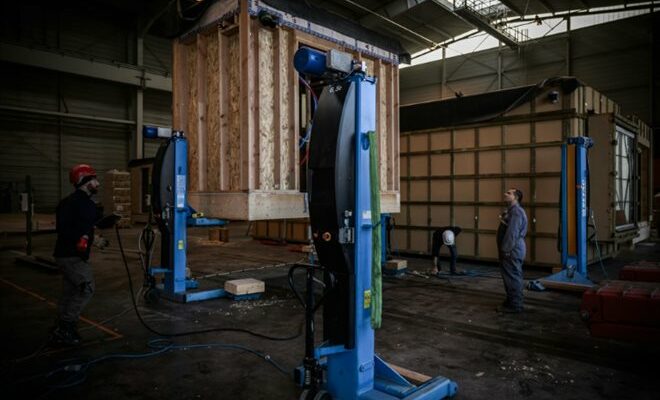In a modular house construction workshop, in Langon (Gironde), January 23, 2024 (AFP/Philippe LOPEZ)
Manufacture elements of a building in a factory to then assemble them on the site: “off-site” appeals to construction, for reasons of cost and time, but also to accelerate its decarbonization, with more sustainable raw materials.
“Born in the 19th century in North America with the need to welcome European immigrants”, this process has seen renewed interest over the past ten years in France, according to real estate investor Vincent Férat, president of Keys REIM.
The developer Nexity or the social landlord 3F, a subsidiary of Action Logement, are investing in this sector, widely used in the tertiary sector (shops, offices), but also for a collective housing project in Marseille (La Porte Bleue) or a hotel residence from Odalys.
Off-site can be available at different scales: the elements “most consumed are facade panels, prefabricated posts, prefabricated slabs”, specifies Christophe Millet, treasurer of the National Council of the Order of Architects.
But it can also go as far as complete modules which no longer have anything to do with the assembly of bungalows or containers such as we have in mind and which we can do for emergencies, welcoming refugees, etc.”, summarizes Mr. Férat.
– Reduced delivery time –
In Langon, in Gironde, the Ademeure company produces modular houses in former Airbus hangars. The walls are manufactured on an assembly line before being assembled into modules and delivered to the site using an impressive crane lifting system.

A construction element assembled in the workshops of the Ademeure company is transported by truck to its final site, in Langon (Gironde), on January 23, 2024 (AFP/Philippe LOPEZ)
“It surprises the neighborhood, in the morning, they leave, the land is empty, in the evening, there is a house,” joke Mr and Mrs Tatieu, a retired couple who have owned a house of this type since 2021 in the Landes.
Even if it still takes a few weeks to finish assembly on site, this standardized process guarantees a delivery time “less than 12 months, compared to at least 18 in traditional construction”, according to Jonathan Duffié, founder of the company.
It also makes it possible to reduce the cost, with an average price including all equipment of 180,000 euros for the company’s “house M” (95 square meters) and to “limit the use of the subcontractor” and therefore “the trips- truck returns of craftsmen”, he explains.
– Energy savings –
Savings are also made on energy thanks to insulated wooden walls, “from local sectors of New Aquitaine” and “bio-sourced” as well as “a solar panel integrated into the house” producing around 10% of energy consumption, according to him.

In the modular house construction workshops of the Ademeure company, in Langon (Gironde), January 23, 2024 (AFP/Philippe LOPEZ)
Mr and Mrs Tatieu claim to have saved “900 euros per year since moving in”.
“Guaranteeing better energy performance of buildings” so that the sector can achieve the zero carbon objective in 2050 is also at the heart of the charter for the development of off-site construction, adopted last year by social landlords. , developers and communities in the Paris region.
Their objective: to build at least 50% of new programs off-site in Greater Paris by 2031, with the desire to “save materials, energy, resources” or “massify the use of organic materials -sourced and geo-sourced, and limit water consumption.
“Off-site involves the decarbonization of buildings because most of the off-site industry revolves around wood and bio-sourced or geo-sourced materials,” according to Christophe Millet, treasurer of the National Council of the Order of Architects.
But “if the wood comes from Siberia, we have not won the battle. Off-site decarbonization must happen through a local economy, in a local industrial fabric whose resources are local,” he emphasizes.
And while we will “have to build the city on the city, densify” with the Zero Net Artificialization (ZAN) law, off-site can “find its place” provided it “adapts to any type of construction site and to leave creative intelligence to project managers and architects,” he defends.
This sector “seems to go in the direction of ecological transition”, provided that “the transport times and volumes of the modules are not too great”, judges for her part Karine Jan, sustainable building manager at Cerema, Center for studies and expertise on risks, the environment, mobility and planning.
© 2024 AFP
Did you like this article ? Share it with your friends using the buttons below.




